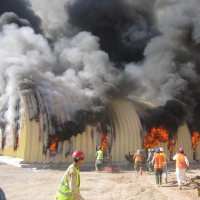Army Corps of Engineers to Leave behind Fire-Prone Buildings in Afghanistan because Occupants are Young, Fit Soldiers who can Flee Quickly
 Afghan National Army Base building on fire during construction (photo: SIGAR)
Afghan National Army Base building on fire during construction (photo: SIGAR)
Is a firetrap not really a firetrap if the occupants are fleet of foot enough to get out of harm’s way?
That’s what the U.S. Army thinks.
In the run up to the American military’s run out of Afghanistan, the Army Corps of Engineers is planning to leave behind barracks for the Afghan army to use. The only problem with this plan is many of the structures are prone to bursting into flames.
But at least one senior American commander doesn’t see a problem with this danger.
“The typical occupant populations for these facilities are young, fit, Afghan soldiers and recruits who have the physical ability to make a hasty retreat during a developing situation,” Major General Michael Eyre, commander of the Army Corps’s Transatlantic Division, wrote in a memo, according to the Special Inspector General for Afghanistan Reconstruction (SIGAR).
The head of SIGAR, John Sopko, did have a problem with the rationalization for turning fire-prone building over to the Afghans.
“I am very troubled by such logic, which seems to argue that fire hazards for a building are somehow remedied by the youthful speed and vigor of the occupants,” Sopko wrote in a letter released to the public. “This logic pales in light of not only the speed with which these buildings will be consumed by fire as well as the fact that a number of the buildings in question are infirmaries and sleeping quarters.”
The Army constructed nearly 1,600 of the oval-shaped structures—two thirds of which were made using materials not up to international building code standards.
About 800 of the firetraps are being refitted.
But 285 of the structures contain a highly flammable, plastic-based insulation that was sprayed onto the walls, making it impossible to eliminate the fire hazard. Those structures include 83 barracks, four medical clinics and two fire stations.
But have no fear, Colonel Richard Heitkamp of the Army Corps’s Transatlantic Division commander, said. The military has seen to it to load these buildings with “further fire protection to mitigate the potential risk” (which was not explained) and “additional egress points” (exit areas for the young and able-bodied to bolt through).
-Noel Brinkerhoff
To Learn More:
Fire-Prone Buildings to be Left at Afghan Bases, Watchdog for Reconstruction Warns (by Ernesto Londono, Washington Post)
More U.S. Money to Burn in Afghanistan, This Time Millions on Faulty Incinerators (by Noel Brinkerhoff, AllGov)
- Top Stories
- Unusual News
- Where is the Money Going?
- Controversies
- U.S. and the World
- Appointments and Resignations
- Latest News
- Trump to Stop Deportations If…
- Trump Denounces World Series
- What If China Invaded the United States?
- Donald Trump Has a Mental Health Problem and It Has a Name
- Trump Goes on Renaming Frenzy






Comments